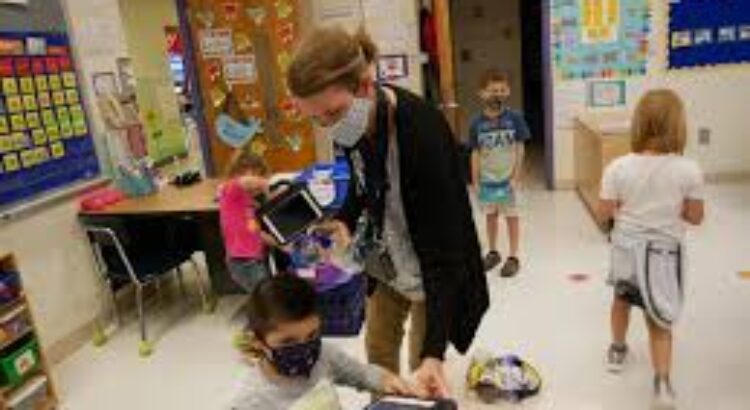Es un primer paso para que los niños regresen a las aulas, aunque no es el único factor.
Casi la mitad de los estados de EU han comenzado a permitir que los maestros se vacunen contra el Covid-19, según un sondeo de The New York Times.
Para esta semana, 24 estados y Washington, D.C. estaban proporcionando vacunas a los profesores de educación básica.
La rapidez con la que los estados aplican las vacunas a docentes se ha convertido en un elemento central del debate sobre cómo reabrir las escuelas, justo cuando surgen y se propagan más variantes de virus contagiosos.
En algunos estados donde muchos maestros ya están enseñando con clases presenciales, los maestros aún no son elegibles para recibir vacunas.
Y para muchos lugares donde las clases son principalmente remotas, vacunar a los maestros ha sido un primer paso para que los niños regresen a las aulas, aunque no es el único factor.
La semana pasada, los Centros para el Control y la Prevención de Enfermedades dieron un mensaje sorprendente: los niños deben regresar a las aulas porque es seguro para ellos hacerlo.
La agencia dijo que la «preponderancia de la evidencia disponible» indicaba que la educación en persona podría llevarse a cabo de manera segura siempre que se mantuviera el uso de cubrebocas y el distanciamiento social.
Los investigadores de los CDC encontraron «poca evidencia de que las escuelas hayan contribuido significativamente a incrementar la transmisión comunitaria» si se seguían las medidas de seguridad adecuadas.
Sin embargo, se hizo una advertencia importante: Los funcionarios locales deben estar dispuestos a imponer medidas en otros entornos, como cenas en interiores, bares o gimnasios mal ventilados, de modo que la infección comunitaria se mantuviera baja.
El debate está lejos de estar resuelto y los sindicatos de docentes de todo el país han presionado para que los profesores sean prioridad en las filas de vacunación.
Oregon comenzó a vacunar a maestros de educación primaria y secundaria el mes pasado, dándoles un lugar antes que algunos residentes de 75 años o más. La Gobernadora Kate Brown dijo que la medida era parte de su plan que los niños regresaran a clases durante este año escolar.
«Por cada maestro que regresa al salón de clases, ayuda a 20, 30, 35 estudiantes a volver a encarrilar sus vidas«, dijo la Gobernadora Kate Brown.
«Ayuda a asegurar que 20, 30, 35 niños tengan acceso a apoyo de salud mental. Se aseguran de que 20, 30, 35 niños tengan desayunos y almuerzos varios días a la semana. Y permiten a las familias saber que sus hijos están en buenas manos cuando van a trabajar».
En Ohio, como parte del objetivo del Gobernador Mike DeWine de reanudar algunas clases en persona para el 1 de marzo, se comenzó a vacunar a maestros en ciertos condados esta semana.
Representantes de sindicatos elogiaron la decisión, pero afirman que no es la única respuesta para regresar a las escuelas de manera segura. Los niños aún no recibirán vacunas, señalan, ni tampoco todos los adultos en los centros educativos.
«Incluso cuando los educadores puedan vacunarse, seguirá siendo de vital importancia seguir todas las pautas de los CDC para mantener nuestras escuelas seguras y abiertas para la instrucción en persona cuando sea posible», dijo Steve DiMauro, presidente de la Asociación de Educación de Ohio, en un comunicado de prensa.
Fuente: https://sipse.com/mundo/estados-unidos-mitad-estados-vacunacion-maestros-391019.html















 Users Today : 16
Users Today : 16 Total Users : 35460707
Total Users : 35460707 Views Today : 30
Views Today : 30 Total views : 3419854
Total views : 3419854